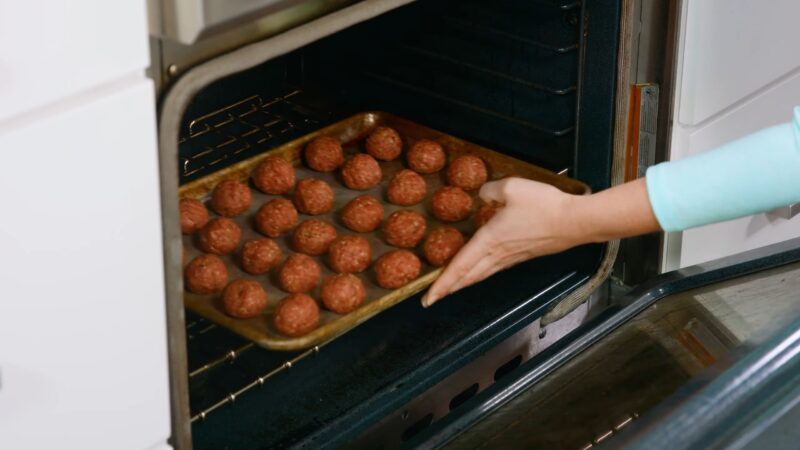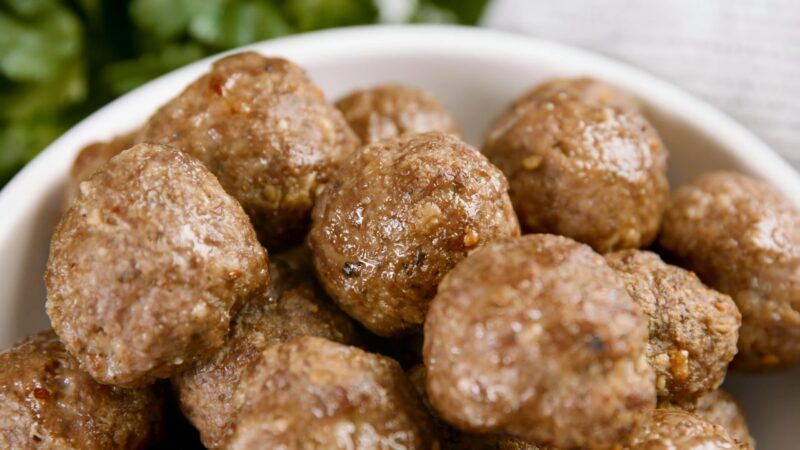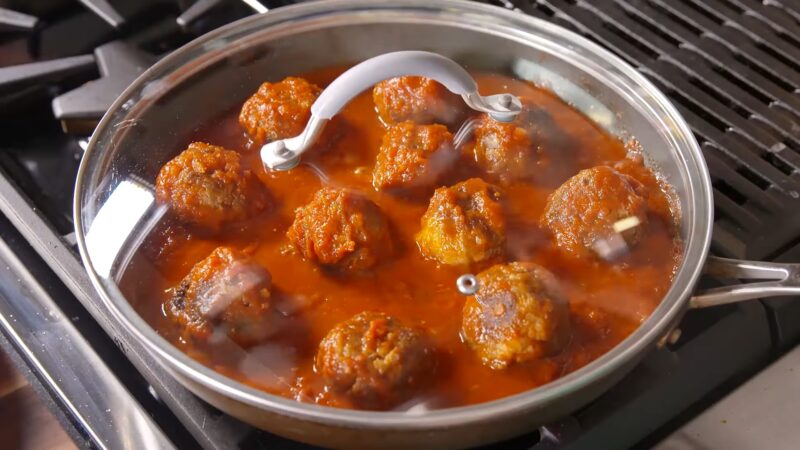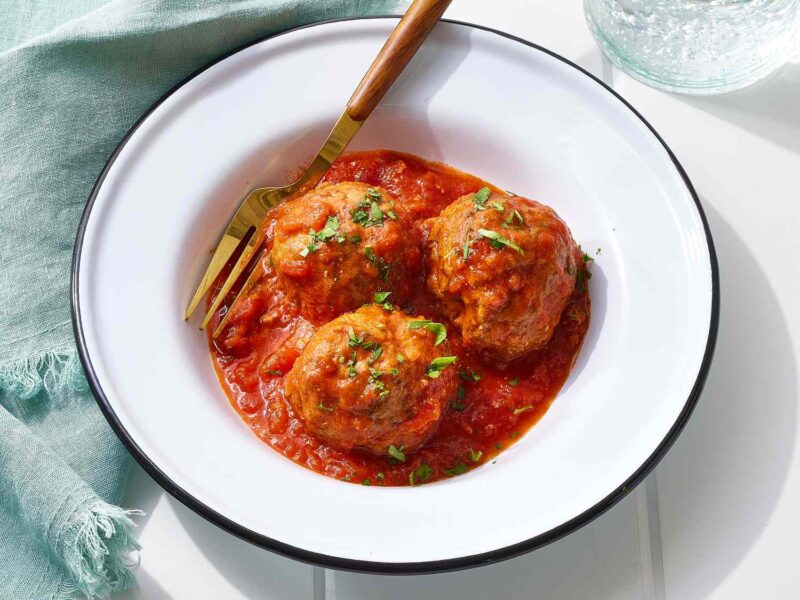The key to achieving juicy, tender meatballs lies in the balance of temperature and time. By ensuring your oven is preheated to the right temperature and your meatballs reach the correct internal temperature, you can enjoy delicious results every time.
If you are not sure about proper cooking time, stay with me because I will share some important insights in the following sections.
Key Takeaways
- In most cases, required cooking time is up to 30 minutes.
- The recommended temperature is 350 degrees Fahrenheit.
- Variations in recipe could mean longer or shorter cooking time.
So, How Long It Takes?

The duration to cook this dish in the oven typically ranges from 25 to 30 minutes at 350 degrees Fahrenheit. However, factors such as the size of the meatballs and the type of meat used can influence cooking time.
Smaller meatballs may require less time, while larger ones might need more to ensure they’re cooked thoroughly. Always aim for an internal temperature of 165 degrees Fahrenheit to ensure they are safely cooked.
What if I Take Them Out Too Soon?
Taking it out of the oven too soon can result in undercooked meat, which may be unsafe to eat. Undercooked meatballs will have a pink center and may be cooler than 165 degrees Fahrenheit internally.
If you suspect they are not fully cooked, it’s crucial to return them to the oven until they reach a safe internal temperature. Using a meat thermometer can help you accurately determine if they have cooked sufficiently.
How to Recognize the Meal is Done?

The right way to be sure is to check the internal temperature and observe the color. Fully cooked meatballs will have an internal temperature of 165 degrees Fahrenheit and show no pink in the center.
Additionally, the exterior should have a nice, evenly browned crust. If you’re unsure, a meat thermometer is a reliable tool that can help ensure your meatballs are perfectly cooked every time.
Variations Depend on the Recipe
The time needed to cook meatballs in the oven varies, influenced by several factors. It’s not always about sticking strictly to the 25 to 30 minutes initially suggested. Understanding these variations will ensure your meatballs come out perfectly every time.
Meatball Size

- Smaller Meatballs: Require less time, potentially only 20 minutes.
- Larger Meatballs: May need more than 30 minutes to cook thoroughly.
Ingredients Used

- Moist Ingredients: Additives like vegetables or added sauces can extend cooking time.
- Type of Meat: Lean meats such as turkey or chicken might cook differently compared to beef or pork, affecting time.
Cooking Method

- Baking: The standard approach, with adjustments needed based on size and ingredients.
- Broiling: For a crisper exterior, a few minutes under the broiler after baking might be necessary.
- Cooking in Sauce: Directly cooking in sauce on the stovetop or in a slow cooker offers a different texture and might alter cooking duration.
Bonus Recipe – Classic Meatballs
This classic meatball recipe is a timeless favorite, perfect for a hearty family dinner or as a savory appetizer. Follow this straightforward guide to create tender, flavorful meatballs that will become a go-to in your culinary repertoire.
Ingredients

- 1 pound ground beef
- 1/2 pound ground pork
- 2 cloves garlic, minced
- 1/4 cup fresh parsley, chopped
- 1/2 cup grated Parmesan cheese
- 1 cup breadcrumbs
- 2 large eggs, beaten
- 1 teaspoon Kosher salt
- 1/2 teaspoon black pepper
Instructions
- Preheat Oven: Set your oven to 350 degrees Fahrenheit and line a baking sheet with parchment paper.
- Mix Ingredients: In a large bowl, combine the ground beef, ground pork, garlic, parsley, grated Parmesan, breadcrumbs, eggs, salt, and pepper. Mix until just combined—avoid overmixing to keep the meatballs tender.
- Form Meatballs: Scoop the mixture and roll into golf ball-sized meatballs. Arrange them on the prepared baking sheet, ensuring they are not touching.
- Bake: Place the meatballs in the oven and bake for 25-30 minutes, or until they are browned and cooked through. The internal temperature should reach 165 degrees Fahrenheit.
- Serve: Serve the meatballs hot with your favorite sauce, pasta, or as a stand-alone dish with a side of vegetables.
For an unusual twist, blend a spoonful of green pesto into your meatball mixture for a vibrant burst of basil and Parmesan flavor.
Alternatives

- For a Lighter Version: Substitute ground turkey or chicken for the beef and pork for a leaner option.
- Vegetarian Option: Use lentils or a meat substitute in place of ground meats, adjusting the binding ingredients as necessary to hold the meatballs together.
- Gluten-Free: Replace breadcrumbs with a gluten-free alternative such as rolled oats or almond flour.
- Spice It Up: Add red pepper flakes or a pinch of cayenne pepper to the mixture for a spicier version.
- Cooking Method: Instead of baking, try frying the meatballs in a skillet for a crispy exterior or simmering them directly in your favorite sauce for extra flavor.
FAQs
Can meatballs be a little pink?
Yes, meatballs can be slightly pink in the middle as long as they reach an internal temperature of 165 degrees Fahrenheit. This ensures they are safe to eat despite the pink color.
Do I need to brown meatballs before baking?
Browning meatballs before baking is not mandatory, but it adds flavor and texture. It also helps them hold their shape better while cooking.
Can you overcook meatballs?
Yes, meatballs can be overcooked, leading to a dry and tough texture. It’s important to monitor their temperature and cooking time closely.
Why do my meatballs fall apart when I cook them?
Meatballs fall apart due to lack of binders like eggs or breadcrumbs, or not mixing the ingredients thoroughly. Ensure your mixture is cohesive before cooking.
Do more eggs make meatballs soft?
Yes, adding more eggs to your meatball mixture can make them softer and more tender. Eggs act as a binder and provide moisture.
Conclusion
Creating meatballs is more than following a recipe; it’s about blending tradition with personal touches. The right temperature and cooking time ensure juiciness and safety, while choosing ingredients allows for customization to tastes and dietary needs.
This process is straightforward, focusing on practical steps to achieve delicious outcomes. Whether adding a unique ingredient for a new flavor or adjusting the recipe for health considerations, the aim is to make tasty, satisfying meatballs.
